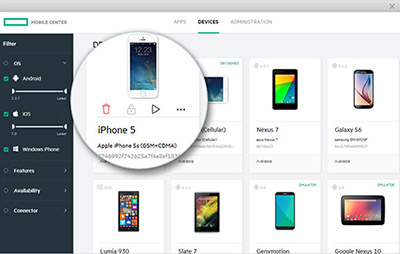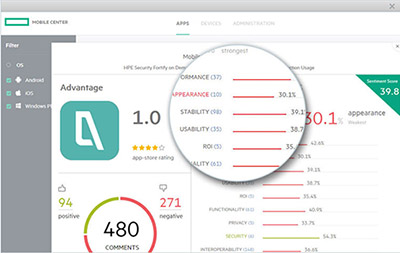HPE Mobile Center 2.0 Drives Mobile App Success with ‘Always On’ Testing -- Combines Lab Tests, Live Monitoring, Analytics
Launching a successful mobile app can feel like a Black Art. HPE Mobile Center 2.0 unifies testing, live monitoring and analytics to help apps pass the ‘mobile moment’ – that 30-second window when a user decides to use -- or drop -- your app. IDN speaks with HPE's Alon Inditzky.

director of
product marketing

"HPE Mobile Center 2.0 takes testing beyond the lab by adding capabilities to track performance and user satisfaction in the real-world."
Launching a successful mobile app can feel like a Black Art. Hewlett Packard Enterprise is trying to shine a light onto that art – and deliver smarter app testing to help ensure the app being built will be used, even loved.
Teams of developers, IT and business managers working on mobile apps often spend weeks or months collaborating with little guarantee of success. They would design, test, clean up any bugs, test again, launch – and then still have to cross their fingers.
HPE Software’s director of product marketing Alon Inditzky says there needs to be a better way to ensure mobile app success. They key, he said, could lie in a more informed approach to testing – one that takes testing beyond the lab to real-world usage.
“It’s time to expand the scope of traditional [app] testing, and focus on the bigger picture of how to create and maintain great user experience,” Inditzky told IDN. Enter HPE’s latest update its Mobile Center mobile app testing platform. “HPE’s Mobile Center 2.0 expands the platform’s capabilities “to provide a predictable and repeatable mechanism for testing, monitoring, and improving any mobile app,” he said.
HPE’s Mobile Center 2.0 combines testing for 200+ devices and major carriers with live monitoring, analytics and even sentiment analysis. The idea is to increase the odds that an app will be successful, and put companies in a position that can make quick adjustments when an app may not be, Inditzky added.
Mobile Center 2.0 “takes testing beyond the lab by adding capabilities to track the mobile app performance and user satisfaction in the real-world,” he said.
As a result, Mobile Center 2.0 delivers a “full lifecycle approach to app testing,” combining pre-launch testing (for apps, devices and carriers) with real-time live monitoring, user analytics, sentiment analysis and more.
Mobile Center 2.0 also leverages HPE’s strengths in machine learning and security to provide deep intelligence to guide developers in building a high-quality and secure app.
Further, it integrates with popular open source tools, such as Selenium and Appium, to let developers continue using the tools of their choice,,Inditzky added.
The power of Mobile Center 2.0’s end-to-end approach can be illustrated by a mobile retail app.
“With Mobile Center 2.0, if I have a retail app, I can know exactly 81% of my users are launching app, searching for category items or adding it to their cart. Of those, I can see 80% are running on 4 different devices. I can also know that 70% of all users are using T-Mobile, AT&T or Verizon from the East Coast,” Inditzky said.
Beyond that, Mobile Center 2.0’s real-time capabilities provides valuable visibility into some crucial app metrics. “If I want, I can also watch every user click, watch the flows, see the scripts being generated and even measure response times from one action to the next,” he added.
It doesn’t take a Ph.D. to see how valuable this kind of detailed visibility into a mobile shopping app might be for figuring out why so many shopping carts are left abandoned, Inditzky suggested. It’s often that the user experience isn’t up to snuff.
A great user experience starts from the first line of code,” Inditzky said. “So, Mobile Center 2.0 lets a developer not simply conduct automated testing, but also interact with the app using manual testing.” Beyond that, mobile teams add security and test again – for both a great individual user experience, as well as for how well the app will perform at scale for thousands, tens of thousands, or more users on different devices and different carriers.
HPE Mobile Center 2.0 also provides mobile teams a single consolidated gateway that provides a central repository to execute tests and manage their on-premises and AWS-based devices and emulators. “Having a single application management gateway for mobile apps can help enhance and refine the performance and quality of any mobile app,” Inditzky added.
With HPE Mobile Center 2.0, Mobile App Testing ‘Never Stops’
Beyond its ‘lifecycle approach’ to testing, there is a companion idea behind HPE Mobile Center 2.0: “Testing never stops,” Inditzky said.
“Even after an app passes pre-launch tests and is launched, testing and data gathering on how well the app is meeting user expectations goes on,” he said. “In this way, HPE Mobile Center 2.0 presents a complete on-going picture of how well an app is performing to meet user needs,” he added.
HPE is the latest company to break through traditional boundaries of mobile testing.
Architecturally, HPE’s approach with Mobile Center 2.0 is designed to support multi-dimensional testing -- performance, manual, functional and security. It supplements this with ways to test for user experience, thanks in large part to an ‘always on’ console that presents live coordinated views into actual user operation for many of the aspects where a mobile app can succeed -- or fail.
This live coordinated view is enabled, in part, with Mobile Center 2.0’s upgraded central repository. It executes tests, manages devices and emulators, and capture production data from real-world users, Inditzky said.
Among other HPE Mobile Center 2.0’s notable ‘always-on’ app testing, lifecycle features are:

* A cloud-based test lab-as-a service powered by Amazon Web Services to test performance for devices, powered by Amazon Web Services. The AWS Device Farm provides a stable of more than 280 different iOS, Android and Fire phones and tablets that developers can access to test the functionality of their apps.
“By integrating with AWS Device Farm, HPE Mobile Center enables streamlined dev and test for developers to test the real user experience of their apps across multiple device types at scale,” said Marco Argenti, AWS vice president for Mobile and IoT.
“With its support to simultaneously test on virtual devices in the cloud or on-premises, it also lets teams optimize mobile apps for hybrid environments,” Inditzky added.
* Integration with Appium and Selenium frameworks, adding enterprise-grade features such as user, app and lab management. (It also reduces the dependencies for a Mac machine and controls the Springboard when running Appium tests on iOS apps.)
* Ability to capture, analyze and leverage real-world analytics from live mobile app users. HPE Mobile Center 2.0 captures real user activity data by adding support for mobile app monitoring (via integration with HPE AppPulse Mobile and HPE Application Performance Management) and capturing in-app analytics (via integration with HPE Haven OnDemand).
“We instrument every button or swipe or other action an app. That data is instantly sent to the cloud. So, you can get data for a million real live users in just a few minutes,” Inditzky said.
* Capture user sentiment analysis and comments into the testing / monitoring lifecycle – a way to evaluate the next round of new update features, using direct user input. HPE Mobile Center provides a sentiment analysis service that will scan end-user comments on an app, categorize them, and provide a weighted score.
“You can now easily see what your customers are saying, address their concerns by focusing development and testing on the right priorities. Users are talking, so why not listen to them and get the right insights. We let you analyze your app’s current rankings and understanding the trends,” he said.
* Personalized dashboard views for different persona: developer, tester, production, security even DevOps. “Each persona has his own perspective, so we bring push notifications to different personas to help better inform everyone working on an app how what they are working on may affect the app in other places,” Inditzky said.
All these capabilities add up to : HPE Mobile Center 2.0’s ability to help ensure mobile apps – at launch and on an on-going basis – will meet many app ‘must haves’ Inditzky said, including:
Mobile performance optimization – Thanks to providing mobile teams an always up-to-date accurate picture of end-to-end mobile performance, HPE combines virtual users and real devices; then runs simple, elastic and realistic tests from multiple geographies across various real-world network conditions.
Replication of real user experiences – These come from HPE’s generating accurate and authentic results by imitating real-user testing conditions and tendencies. Examples include: remote restarts, recording gestures and replaying interactions.
End-to-end mobile security – HPE can assess the security of source code, binaries, and then allow the mobile app to ascertain and report vulnerabilities across the client side.
Real-time monitoring – HPE monitors the application proactively from multiple locations on original devices to identify issues before customers.
HPE’s ‘always-on approach to mobile app testing also can offer a guide to developers and business for future app improvements.
“With our platform, you don’t need to guess where or how you can improve your app’s next upgrade. You’ll have real data to guide you on how users like – or dislike – an app,” Inditzky said. “For example, you can see social [rankings] that most of the points your app lost were lost due to crashes. So, in our console, you can click on crashes and see how many users crashed the app. You may see that many of those users haven’t updated to the latest version.” This may lead to a number of solutions, he added, including app adjustments or push messages to prompt users to update.
Ensure App Success – Making the Grade During the ‘Mobile Moment’
“The best way to ensure mobile app success is to test your app for the Mobile Moment,” Inditzky said, explaining it this way: “Once a user downloads an app from the app store, you have a very short window -- probably no more than 30 seconds -- to convince the user to use your app or drop it forever,” he said.
For any app to sail through that ‘Mobile Moment’ of decision, Inditzky said an app needs several key qualities:

- To perform well (on multiple devices and mobile carriers)
- Offer great features that are responsive, easy-to-use (or understand),
- Provide users what they expect / need – and
- Take care of security concerns (for data, user identity, etc.)
Of all these, performance is now of growing importance. “Performance is now a ‘must-have’ feature,” Inditzky said. “You may have beautiful sexy features, but if they are not performing well, it’s all for nothing. When someone taps on something [in your app] people want it instantly, and that means less than 10 seconds or so. And, what’s crucial is that these days, your app really only has one chance to impress a prospective user. If it doesn’t, there’s no turning back. All that investment may be lost, and forever.” he added.
“To meet that bar, performance and functional testing are no longer enough. Having detailed info – from the lab and the field, is the key to an app’s ability to meet the ‘Mobile Moment,’” he added.
Mobile Center 2.0 is also designed to integrate with other HPE solutions, including: HPE Fortify on Demand, HPE Sprinter, HPE Unified Functional Testing, HPE LeanFT, HPE LoadRunner, HPE StormRunner Load, HPE Performance Center, HPE Network Virtualization, Appium, and Selenium.
HPE, AWS Team on Cloud-Based Testing with SaaS-Based StormRunner Load
HPE is also bringing the power of analytics-driven performance testing to mobile teams by directly offering HPE StormRunner Load on AWS Marketplace.
The AWS-HPE solution will help developers find and optimize performance bottlenecks while keeping up with diminishing delivery cycle times. “The Stormrunner SaaS solution is optimized for agile development teams, and will streamline web and mobile application development,” Inditzky said.
“HPE StormRunner Load is a SaaS follow-on from HPE’s long-time performance testing software LoadRunner,” he added.
“Nowadays, agile teams are looking for cloud-based testing for web and mobile apps. We offer performance testing before an app goes into production – to make sure the app’s experience remains at the highest level, even with peak traffic,” Inditzky said.
With Stormrunner Load on AWS, “We can tell you to look at a specific area of your app, and we predict if you’ll scale to what level,” he said. “Beyond that, we’ll show you where in your code – both the app and in the app server – where you might suffer the performance bottlenecks, and suggest what could be optimized to result in better performance.”
“Developers can choose to test their app and loads across different geo-locations, different carriers and various devices,” Inditzky said. “As far as test results, developers get detailed reports, analysis of the precise lines of code that may be causing issues and even analytics to identify areas that may cause problems when an app is running at higher scale,” he added.
Much of HPE Stormrunner SaaS’s predictive capabilities comes from HP Labs’ algorithm technologies. “The SaaS testing solution also leverages AWS to provision and run mobile apps worldwide,” he said.



